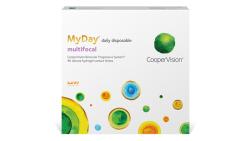
Bifocal contact lenses are lenses designed to address the focusing issues associated with presbyopia by incorporating different prescriptions.
“Presbyopia” is the vision problem that everyone encounters between the ages of 40 and 45. During this time, your eyes lose the ability to focus clearly on small text that’s close to you, like a newspaper, menu, or book.
Bifocals can help you read. But, as we’ll learn, this doesn’t have to be bifocal eyeglasses. To learn more, let’s introduce you to bifocals and walk through what to consider if you’re thinking about getting bifocal contacts.
What are bifocal contact lenses?
Bifocal contact lenses are lenses that offer two different prescriptions in a single lens. One prescription is for close reading, and the other for normal, distance vision. The dual prescriptions help people who suffer from presbyopia, where age-related changes to the eye cause difficulties in focusing on close objects.
What’s the difference between bifocal and multifocal contact lenses?
Bifocal contact lenses are designed with a defined line between the near vision prescription and the distance prescription. You switch back and forth between zones, as you would with bifocal eyeglasses. Multifocal contact lenses have a gradual transition between near and far.
Types of bifocal contacts
-
Segmented bifocal contacts (also referred to as an alternating or translating bifocals). This mimics bifocal eyeglasses closely, with a separate section for each prescription. Usually, the near vision prescription is in the lower part of the lens, and the normal, distance prescription is in the rest of the lens.
-
Concentric design bifocal contacts. The center of the lens has the normal vision prescription, and the surrounding ring has the near vision prescription. This is called a concentric or simultaneous bifocal.
Bifocal lenses come in both soft and rigid gas permeable (RGP) or hard lens materials.
Choosing bifocal contact lenses
Here are some good considerations for deciding whether bifocal contact lenses are for you.
Benefits of bifocals
- No need for reading glasses.
- High visual acuity for both near and distance vision.
- Similar to bifocal eyeglasses, sometimes requiring less adjustment.
Drawbacks to bifocals
- You have to learn how to switch between prescriptions.
- They can sometimes affect depth perception.
- They can cause eye strain, especially when segmented bifocals (with reading prescription in the lower lens) are combined with heavy computer work.
Bifocal contact lens alternatives
There are many good non-surgical alternatives if bifocals don’t sound appealing to you, or if they're not the most appropriate option, including:
- Multifocal contact lenses
- Normal, distance contacts combined with reading glasses
- Monovision contact lenses
Remember, getting or switching contact lenses is a decision you should make with your eye doctor. The correct prescription and fitting is critical to the health, comfort and performance of your eyes.






